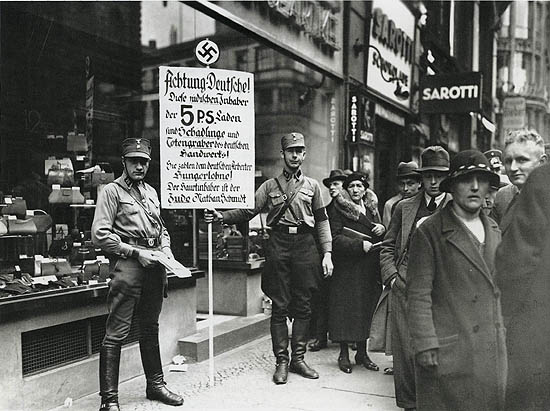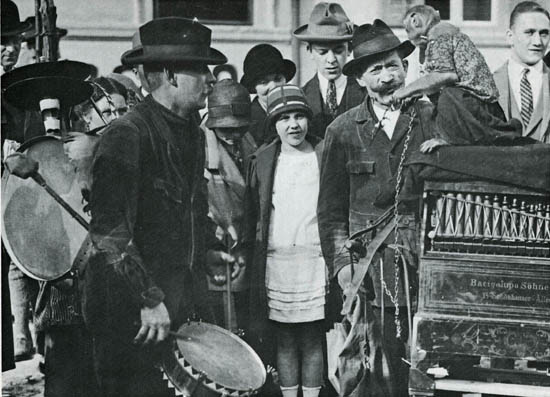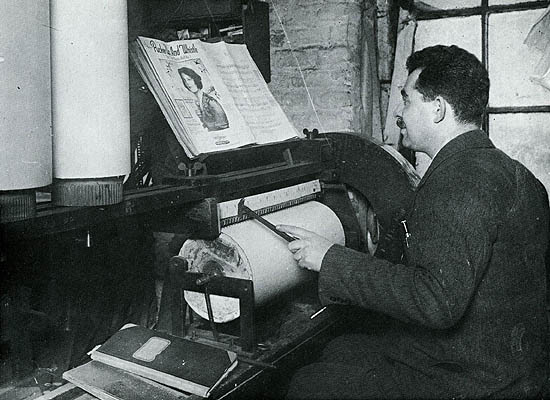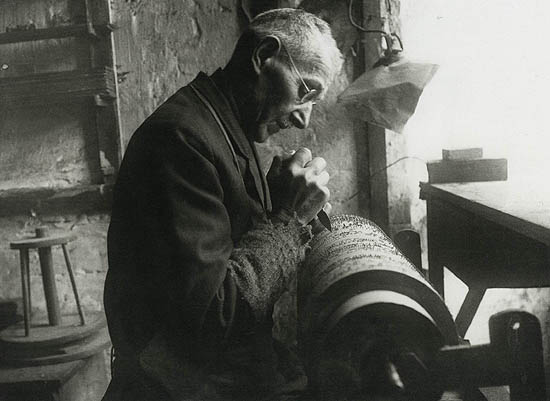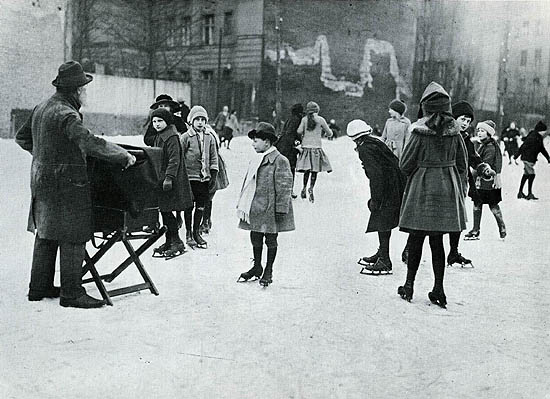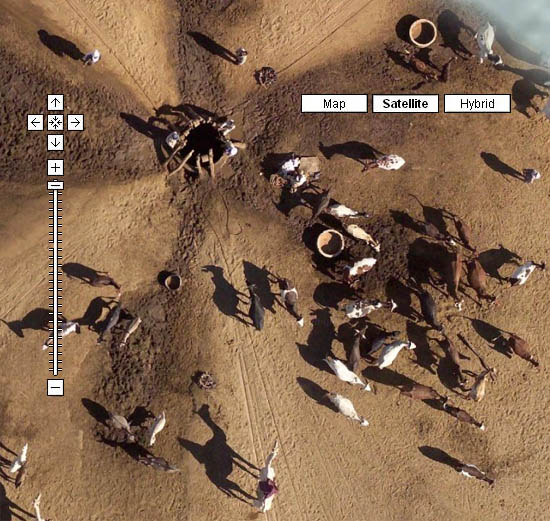Our posts about Berlin (click to enlarge)
Buhse, the shoemaker
 From the photos of Willy Römer about the craftsmen of Berlin in the 1920s, one profession is conspicuously absent: that of the shoemaker. Among his published photos I have found only the above one, which represents not really a shoemaker, but rather a cobbler. Which is not surprising. Shoemaking was one of the first craft trades to become a large-scale industry around the turn of the century, and as Richard Stade reported in 1932 in his Der Niedergang des Schuhmacherhandwerks als Produktionsgewerbe (The fall of shoemaking as a production craft), by the middle of the 1920s the proportion of the craft was only 3% in the total shoe production. We read the same in the following sketch of Gabriele Tergit, the popular column writer of the period, who between 1924 and 1933 published a series in the Berliner Tageblatt on the characteristic figures of the life of Berlin, including the shoemaker.
From the photos of Willy Römer about the craftsmen of Berlin in the 1920s, one profession is conspicuously absent: that of the shoemaker. Among his published photos I have found only the above one, which represents not really a shoemaker, but rather a cobbler. Which is not surprising. Shoemaking was one of the first craft trades to become a large-scale industry around the turn of the century, and as Richard Stade reported in 1932 in his Der Niedergang des Schuhmacherhandwerks als Produktionsgewerbe (The fall of shoemaking as a production craft), by the middle of the 1920s the proportion of the craft was only 3% in the total shoe production. We read the same in the following sketch of Gabriele Tergit, the popular column writer of the period, who between 1924 and 1933 published a series in the Berliner Tageblatt on the characteristic figures of the life of Berlin, including the shoemaker.Gabriele Tergit – by her civil name, Elise Hirschmann – was born in 1894 in Berlin in a Jewish bourgeois family. She learned history, sociology and philosophy, and from 1915 she was one of the first female journalists in Germany. Her concisely and impressively written regular courts reports made her a name – she reported, among other, about the press trials of Hitler and Goebbels –,
 but she also regularly wrote on the everyday life of Berlin (and these articles were always immediately taken over also in the Prager Tageblatt). In 1931 she also published a novel entitled Käsebier erobert den Kurfürstendamm (Käsebier conquers the Kaiserdamm), in which she wrote, through the world of the Neukölln cafés, about the power of advertisement and propaganda, foreshadowing the propaganda of Goebbels – about this book we will write separately. But she also wrote about the cultural history of flowers, in whose title we can also find the imperial crown. In 1933 with an incredible luck she managed to escape to London from the Nazi purge, but her writing career, like of many other German refugees, was interrupted. In her home country she was discovered only in 1977 on the occasion of the “Berliner Festwochen”. She died in London in 1982. Her short sketches on the everyday life of Berlin were collected in 1994 by Jens Brüning at the Suhrkamp publisher with the title Atem einer anderen Welt: Berliner Reportagen (Breath of another life: Reports in Berlin). From this volume we translate the following essay.
but she also regularly wrote on the everyday life of Berlin (and these articles were always immediately taken over also in the Prager Tageblatt). In 1931 she also published a novel entitled Käsebier erobert den Kurfürstendamm (Käsebier conquers the Kaiserdamm), in which she wrote, through the world of the Neukölln cafés, about the power of advertisement and propaganda, foreshadowing the propaganda of Goebbels – about this book we will write separately. But she also wrote about the cultural history of flowers, in whose title we can also find the imperial crown. In 1933 with an incredible luck she managed to escape to London from the Nazi purge, but her writing career, like of many other German refugees, was interrupted. In her home country she was discovered only in 1977 on the occasion of the “Berliner Festwochen”. She died in London in 1982. Her short sketches on the everyday life of Berlin were collected in 1994 by Jens Brüning at the Suhrkamp publisher with the title Atem einer anderen Welt: Berliner Reportagen (Breath of another life: Reports in Berlin). From this volume we translate the following essay.Buhse, the shoemaker
 Buhse is a cobbler, and his workshop is in the basement of a noble house. In his cellar there are two dressers with countless raffle and sideshow trinkets, a piano, a wardrobe, a sofa, a table with chairs, and a folding screen that covers the sleeping accommodation. At the table, one step for the purpose of the workshop. But the ornament of the place is a large framed diploma, with a Gretchen or Evchen at the spinning wheel on the bottom left, to make room for a putto to flutter a band, and with a female figure to the right – the Freedom, the Electricity or the Industry – holding a torch. The whole is the diploma of a silver medal at the 35th shoemakers’ exhibition in Biesteritz.
Buhse is a cobbler, and his workshop is in the basement of a noble house. In his cellar there are two dressers with countless raffle and sideshow trinkets, a piano, a wardrobe, a sofa, a table with chairs, and a folding screen that covers the sleeping accommodation. At the table, one step for the purpose of the workshop. But the ornament of the place is a large framed diploma, with a Gretchen or Evchen at the spinning wheel on the bottom left, to make room for a putto to flutter a band, and with a female figure to the right – the Freedom, the Electricity or the Industry – holding a torch. The whole is the diploma of a silver medal at the 35th shoemakers’ exhibition in Biesteritz.Buhse is the son of a carpenter from Pasewalk. When he was 25 years old, he married the maid of Countess Zetlitz, and got a golden pendulum clock as a wedding gift. She held a stately home, and did not speak to the porter’s wife. Buhse made boots and saffian slippers and elastic-sided shoes. Over time, he got less and less orders for new shoes, and more and more resoling and mending on shoes which he himself would have made much better. As the first gray hairs came, he dyed them black. His son married an easy girl and got into evil ways. Buhse remained with a granddaughter who married early and already had her first child. So he had child’s crying in his cellar by his old age again.
On the first floor the Consul’s wife said to her husband: “I’ve never had such a good cobbler. To him I would even trust my silk shoes. The Consul looked up from his newspaper. “Yes, yes, good craftsmen are a rarity nowadays. Such people must be supported, one has to give them occasion to earn some money.” So after twelve years Buhse got a commission for a pair of new boots.
 He arrived with a large sheet of paper and a pencil to take measure.
He arrived with a large sheet of paper and a pencil to take measure.From morning till night Buhse went about the leather stores, he was looking for calfskin. He knew leather. When he sat late to the table, and his granddaughter was peevish, he just smiled. He negotiated for a long time, but finally he had it, the impeccable piece of calfskin, this poem, this dream, this idea of a calfskin. Not a piece of cardboard was put into the boots.
“My dear Mr. Buhse”, the Consul said, “I’m really sorry, but the boots are too tight. Please change them, or else…” “But please,” interrupted him Buhse, the shoemaker, “I will of course make a new pair!” Buhse tried to change. It did not go. “That’s it”, he mused, as he began a new pair, “that’s it. One just sit here and torments himself to stuff the mouths, and for the rent and taxes, and forgets everything, and forever mends and heels and resoles, and once one could really show what he knows, he knows nothing any more.” The second pair was completed.
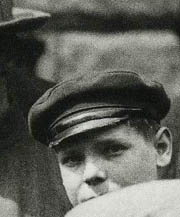 “My dear”, the Consul said to his wife, “I cannot wear the new boots of Buhse either, they also hurt.”
“My dear”, the Consul said to his wife, “I cannot wear the new boots of Buhse either, they also hurt.”“Haven’t I always told?”, the woman replied triumphantly, “that I don’t know what you like in these backward craftsmen? One cannot open enough windows!” In her youth she read a lot of Ibsen. Buhse waited. Perhaps for a gold medal for the pair of peerless calfskin boots, perhaps for his guild master’s appointment, perhaps to the moved visit of the Consul: “Your boots! One flies in them like a bee! All my friends will only work with you!” Two weeks passed, and Buhse stood in his way. “You work very well”, the Consul said, “but they still hurt a bit. But one can still wear them,” he added as he looked at Buhse’s face.
“They do not notice anything”, thought Buhse, “whether the insert is of cardboard or of good leather, whether you work properly with a steel rail or not, they do not notice anything, anything, it’s all the same to them.” In the evening Koller, the upholsterer Koller from the Gneisenaustraße and the carpenter Koblank sat together.
 “They do not notice anything”, said Buhse, “whether the insert is of cardboard or of good leather, whether you work properly with a steel rail or not, they do not notice anything.” “Yes”, said Koller, “they buy the couch for 39,40 marks, they have no idea about it. I know how it’s done, in the evening they sweep up the workshop, they collect the fallen wool and all dirt, they always spare out the proper filling. And people are so stupid, especially the ladies. They just plump upon it, have a look at the cover, and they say: “Yes, it is really worth the fee!” They understand nothing about the inside.
“They do not notice anything”, said Buhse, “whether the insert is of cardboard or of good leather, whether you work properly with a steel rail or not, they do not notice anything.” “Yes”, said Koller, “they buy the couch for 39,40 marks, they have no idea about it. I know how it’s done, in the evening they sweep up the workshop, they collect the fallen wool and all dirt, they always spare out the proper filling. And people are so stupid, especially the ladies. They just plump upon it, have a look at the cover, and they say: “Yes, it is really worth the fee!” They understand nothing about the inside.Koblank added: “Yesterday morning the buyer was there again. Just let it be cheap, regardless of whether the wood will crack afterwards, nobody glues twice nowadays. People are so stupid that if it lasts for a long time, they are unhappy, instead of saying, the man did a good job.”
“But then, when they will have corns and crippled toes, then they will regret”, said Buhse, the shoemaker.
“Not even then”, said Koller, and spat to one side.

auf Deutsch • magyarul
In praise of craft
 “Organ grinder with the monkey, which entertained the children with tricks, and then collected
“Organ grinder with the monkey, which entertained the children with tricks, and then collected money for the organ grinder, and sweets for himself. (1925)” (The captions in
quotation marks were written by Willy Römer on the back of his photos.)
Franz Schubert, Die Winterreise Op. 89. XXIV: The organ-grinder (Der Leiermann). Sung by Dietrich Fischer Dieskau
The photographer, Willy Römer (1887-1979) was one of the most prominent photojournalists in Berlin between the two world wars. He started to learn the profession in 1903, at the age of sixteen, at the first press-photo company of Berlin, the Berliner Illustration-Gesellschaft, and then his master, Karl Delius took him to Paris for four years. In the world war he was a soldier at the Eastern front, but he also brought there his heavy 13×18 camera, and took hundreds of photos in Russian Poland, Belarus and Warsaw’s Jewish quarter, typically not on military actions, but about local life – we will write about them separately. And at the end of 1918, having returned to Berlin, he walked the streets from dawn to dusk, photographing the revolution, including the moment of his own arrest.
 Arrest warrant against Willy Römer photographing the revolutionaries,
Arrest warrant against Willy Römer photographing the revolutionaries, on the Lindenstraße, 5 January 1919.
 Returning home he purchased the Phototek company, founded not much earlier by his colleague Robert Sennecke at Belle-Alliance-Straße 82 in Kreuzberg (today Mehringdamm 58), and after his colleague from Paris, Walter Bernstein became sales manager and co-owner in 1920, they made the company one of the most important press photo agencies of Berlin between the two world wars. Römer and his four “operators” went around the city all the day on the basis of the events chosen in the morning fom the newspapers, and they sent daily 10-12 photos to about 250 newspapers all over the world.
Returning home he purchased the Phototek company, founded not much earlier by his colleague Robert Sennecke at Belle-Alliance-Straße 82 in Kreuzberg (today Mehringdamm 58), and after his colleague from Paris, Walter Bernstein became sales manager and co-owner in 1920, they made the company one of the most important press photo agencies of Berlin between the two world wars. Römer and his four “operators” went around the city all the day on the basis of the events chosen in the morning fom the newspapers, and they sent daily 10-12 photos to about 250 newspapers all over the world.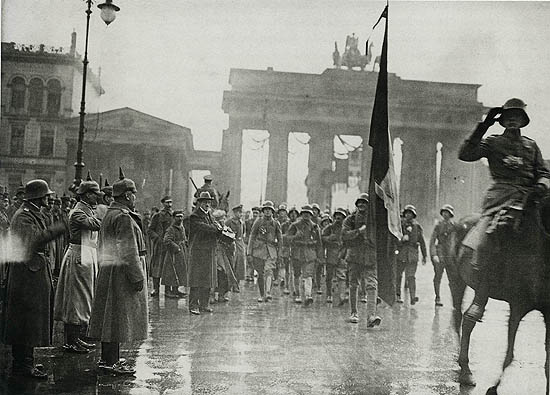 Press photographer Walter Gircke in eye contact with Willy Römer during the reception of the returning German troops at the Brandenburg Gate. Berlin, probably on 10 December 1918.
Press photographer Walter Gircke in eye contact with Willy Römer during the reception of the returning German troops at the Brandenburg Gate. Berlin, probably on 10 December 1918.The prosperity of Phototek was interupted in 1933, when the new system declared the company “Judenfirma” because of Bernstein’s origin, and prohibited the German press to buy photos fom them. The company soon went into bankruptcy, and Römer continued to work as a lonely photographer under difficult conditions.
But either as the owner of a prestigious press photo company, who can afford to devote a part of the working day to his passion, or as a lonely photographer who, in lack of orders, can deal with his own hobby, Willy Römer always photographed what he loved: the daily life of Berlin. The street life, political events, children’s games, river boats, courtyards, entertainers and bear-leaders. And, of course, organ-grinders.
We are also accustomed to the fact that the photos of organ grinders have their conventional composition. These are genre scenes, mostly with a worn-looking, comically or nostalgically anachronistic old man and music box, on which the photographer looks in amazement as on the figure of a past age, and he himself does not quite find a place in this world. Römer’s organ-grinder shootings do not follow this cliché. Photographing organ-grinders fitted for him into a larger concept: the detailed documentation of handicrafts in contemporary Berlin.
The recorded music is actually Bill Murray’s Pucker Up and Whistle from 1921, a piece really fitting to the barrel organ. For its video with subtitles see here
The iconography of work started to develop in photography relatively late, around the turn of the century, mainly as a critique of the alienated work in the large industrial factories and in order to show up its alternatives, first through the more or less idealized genre scenes of rural works and traditional crafts, and later through politically charged workers’ representations. However, Willy Römer’s photos on working in Berlin do not fit to any of these trends. He himself grew up in a Berlin artisan family, the son of a tailor, and it seems that he was primarily interested in documenting objectively and in its context the artisanal crafts which in the Berlin of the 20s still gave bread to nearly 300 thousand people, a third of the city’s workers. He captured in detailed photo series the complete work process of bakers, chimney sweepers, the washerwomen of Köpenick, caters, boatmen and fishermen, nail-smiths, file-makers and street vendors.

To these works belongs also that of the organ-grinder, which Römer followed with his camera from the beginning, the preparation of the barrel organ and the inclusion of the tune cylinders to the organizing of the street presentation. His photos represent the organ-grinder not an anachronistic figure, but a master craftsman professionally performing his job, and also present the context of the performances, the collaboration of the organ-grinder, the entertainers and the public.

The nearly 70 thousand-piece photo legacy of Willy Römer, one of the few complete photo archives from the Weimar era, after being offered in vain for sale by his widow and daughter to several Berlin museums, was eventually purchased by Diethart Kerbs, the recently deceased renowned photo historian of the arts college of Berlin-Charlottenburg. He published a first selection of them in thirty thematic booklets between 1983 and 1991 with the title Edition Phototek at the Dirk Nishen publisher in Kreuzberg. The first volume of the series presented precisely the organ-grinders. Diethart Kerbs writes about them in the postscript of the booklet:
“At a time when there were no radios, record players and tape recorders, and the TV was not yet invented, the organ-grinders and other courtyard and street musicians mediated sensual pleasures for the ears of broad social layers. The sweet syrup of light tunes on the back bread of everyday life offered a welcome occasion to look out from the window, to come out in front of the store or workshop door, to run down to the court, to take a break, to keep a neighborly chat: music as a social event. The organ-grinder brought the goods of euphony for free in the backyards, and had to ask for the fee that was thrown to them in the form of small coins out of the window. They had to play together a living on long walks through the city.
The organ-grinders had two classes: an upper class, who had their own barrel organs, and a lower class, who had to borrow the equipment for a rental fee.The focus of organ construction and rental was in the north of Berlin. There lived mainly workers and artisans, many of them immigrants from Eastern European counties, but also from Italy. The Italians of northeastern Berlin included the Bacigalupo family, who founded in 1877 their barrel organ factory at
 Schönhauser Allee 74, and later moved it into 74a. In these workshops they manufactured, repaired, sold and rented the barrel organs.”
Schönhauser Allee 74, and later moved it into 74a. In these workshops they manufactured, repaired, sold and rented the barrel organs.”Willy Römer’s photos were rediscovered in recent years. In 2004, the Deutsches Historisches Museum in Berlin, and then the Museum der Stadt Wien organized an exhibition of them, and they have since released several albums. Soon we will also write on some of his other subjects.
auf Deutsch • magyarul
Farewell to Mount Ararat

|
|

The cult of Saint Gregory the Illuminator, the apostle of the Armenians was unbroken from the beginnings among the Armenians of Transylvania. This is indicated by the large number of altarpieces representing the saint baptizing King Tiridates III of Armenia, among other in the Armenian churches of Szamosújvár (Gherla), Erzsébetváros (Dumbrăveni), Csíkszépvíz (Frumoasa), or in the Franciscan churches of Dés (Dej) and Nagyszeben (Sibiu).
The altarpieces of the Armenian church of Gyergyószentmiklós (Gheorgheni) and of the Salamon Church in Szamosújvár (Gherla) differ from the rest of these representations. Although their central scene is the same baptism, this is encircled by a “narrative frame”, a set of medaillons illustrating the tortures of St. Gregory, and thus connecting these images more closely with the late 5th-century History of the Armenians by Agathangelos, which narrates the legend of the saint. The Gyergyószentmiklós altarpiece is an especially nice evidence of this connection, as the medaillons are also accompanied by brief explanatory texts.
 The former altarpiece of the Salamon Church in Szamosújvár, early 18th c.
The former altarpiece of the Salamon Church in Szamosújvár, early 18th c.(Armenian Catholic Parish, Szamosújvár / Gherla)
Our guide, Emese Pál pointed out a curiosity in the Szamosújvár painting, which has not been mentioned either at the exhibition or in the catalog. A restorer, probably not knowing the legend of the saint – which recounts the transformation of the king into a wild boar after incarcerating Gregory – misunderstood the medallion representing this scene, and “corrected” the crowned boar into a lamb.
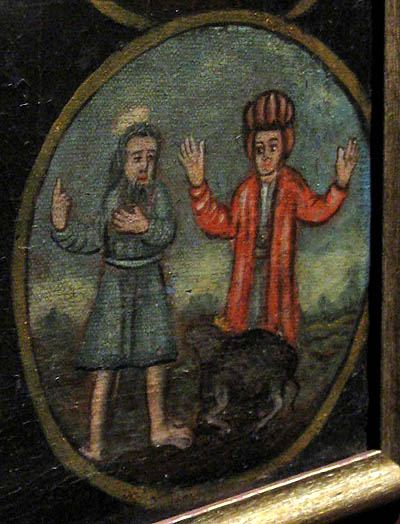
For the large number of small discoveries accompanying an exhibition, a good example is the painting of Szamosújvár, which was hitherto supposed to represent Stephanowicz Roska, the Armenian provost of Stanisławów. The unveiling of the misidentification, told Emese Pál, was the merit of a lady visiting the exhibition from Lemberg, who pointed out, that on the basis of local analogies the portrait represents the Armenian archbishop of Lemberg, Jacob Stephan Augustinowicz. In fact, the inventories of Szamosújvár listed it as Augustinowicz’s portrait until as long as 1877, when a careful hand stroke out his name and wrote Roska’s above it, thereby misleading generations of researchers, from the 19th-century Armenian monographer of Szamosújvár Kristóf Szongott until today.

The studies in the catalog – about which we will write separately – are organized around the themes presented in the exhibition, expanding in a shorter or longer extent the historical and social context of the Transylvanian Armenians, which we previously missed so much, or eventually go further on certain topics not touched in the exhibition. Such are the writings of the two Armenian authors, Armenuhi Drost-Abgarjan’s beautiful essay on the Armenian art of writing and book culture, and Meliné Pehlivanian’s brief summary on the beginnings of Armenian typography. As to the Hungarian aspects, the essay of Máté Tamáska deserves special mention, as it presents the culturally diverse urban milieu of Szamosújvár, the place of origin of most of the exhibited items, which rather remained in the background at the exhibition.
The overall picture emerging from the papers – perhaps because of the tight deadline – seems a bit slim, but the ground-breaking character of the exhibition, together with the important works published in the last few years, compensates for this impression, and will hopefully prepare the ground for further, deeper researches. We are looking forward to the continuation.

in italiano • auf Deutsch • magyarul
El camino a Chufut-Kale

Si se toma el elektrichka desde Sebastopol hacia el noroeste, después de unos 50 km llegaremos a la ciudad de Bakhchisaray.

En la estación de tren tomamos una marshrutka y pasamos por el palacio del kan tártaro …

...y luego por la mezquita de la ciudad...

...siempre hacia arriba hasta el Monasterio de las Cuevas de Uspenskiy.

A partir de aquí nos adentramos a pie en el campo polvoriento, donde rara vez nos protegerá del sol abrasador la sombra de un árbol. Y después de una caminata de 2 km (que al menos nos parecerá de 10) por fin llegamos a la antigua ciudad de cuevas de Chufut-Kale.

Aunque el nombre significa «fortaleza judía» en el idioma turco de los tártaros, la ciudad fue una fundación bizantina posiblemente del siglo sexto, y más tarde se convirtió en asentamiento de alanos cristianos, familiares de los persas y antepasados de los osetios de hoy en día. Según la Wikipedia:
En 1299 la horda tártara del emir Nogai arrasó la península de Crimea. ... [Chufut-Kale] fue una de las ciudades saqueadas. Habiéndose apoderado de la ciudad, los tártaros acuartelaron allí su guarnición. A la vuelta del siglo XV, los tártaros asentaron artesanos caraítas a lo largo de la línea oriental de fortificaciones y construyeron un segundo muro de defensa para proteger su establecimiento, de este modo surgió una parte nueva de la ciudad.Y allí permanece, en Chufut-Kale, una kenesa caraíta...

...así como el mausoleo de una princesa tártara.

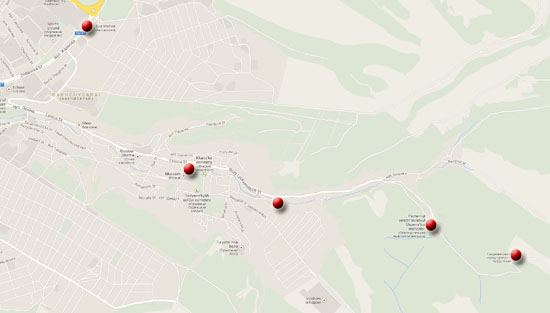 Estaciones principales de la carretera de Bakhchisaray. En tamaño mayor.
Estaciones principales de la carretera de Bakhchisaray. En tamaño mayor.Para otro mapa de Bakhchisaray, ver el atlas de Crimea
in English • in italiano • auf Deutsch • magyarul
The Road to Chufut-Kale

If you take the elektrichka from Sevastopol going northwest, after about 50km you will come to the town of Bakhchisaray.

From the train station there, take a marshrutka past the Palace of the Tatar Khan …

… and past the town mosque …

… all the way up to the Uspenskiy Monastery of the Caves.

From this point, proceed on foot, into the dusty countryside, with rarely so much as a shade tree to protect you from the blistering sunshine. After a 2km hike (which feels like at least 10) you will at last arrive at the ancient cave city of Chufut-Kale.

Although the name means “Jewish Fortress” in the Turkic language of the Tatars, it was founded possibly as early as the 6th century by Byzantines, and later settled by Christian Alans, relatives of the Persians and ancestors of the present-day Ossetes. According to Wikipedia:
In 1299 the Tatar horde of Emir Nogai raided the Crimean peninsula. … [Chufut-Kale] was among the sacked towns. Having seized the town, the Tatars quartered their garrison in it. At the turn of the 15th century, Tatars settled Karaite craftsmen in front of the eastern line of fortifications and built a second defensive wall to protect their settlement, and thus a new part of the town appeared.There remains in Chufut-Kale a Karaite kenassa …

… as well as a mausoleum for a Tatar princess.

 The main stations of the road through Bakhchisaray. In larger size.
The main stations of the road through Bakhchisaray. In larger size.For another map of Bakhchisaray see the atlas of Crimea
en español • in italiano • auf Deutsch • magyarul
Suscribirse a:
Entradas (Atom)

